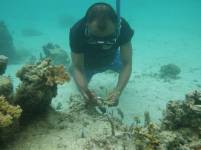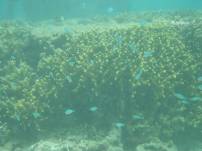Report
International Cooperation in an Environmental Sector by NGO
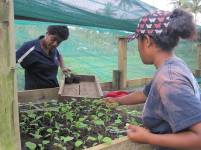 |
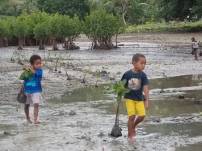 |
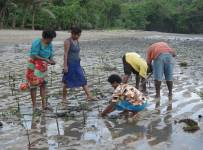 |
Picture 1. Trainees of NYTC. They are taking care of seedlings. |
Picture 2 and 3. Mangrove reforestation program at Navola Village. Many village people joined OISCA’s activity.
|
|
|
|
|
Picture 4. Village people is planting mangroves |
Picture 5. Around the regenerated corals, fishes came back |
|
Rina Kurumisawa ![]()
Department of Environmental Science and Biosphere
Graduate School of Agriculture
Host Organization: OISCA International
Location: Fiji
Duration: 2012.9.7~2012.9.26
Key words: NGO, Environmental conseravation, organic farming, marine environment, environmental education
1. About OISCA International and OISCA International Fiji
OISCA International has long history of consulting on human resource cultivation through rural development and environmental conseravation since 1961.
In Fiji, they started their activity from human resource cultivation through agricultural training at National Youth Training Center (NYTC) as requested by Fijian government since 1990.
Then they have been expanding their activity to environmental conseravation like “Children’s Forest Program” (since 1992), “Mangrove Reforestation Project” (since 1995), “Coral Reef Restoration Project” (since 1997).
In agricultural training, they are teaching organic farming skill from Japan, at the same time they are teaching discipline through well regulated life at NYTC to young trainees. The characteristic of agricultural training in Fiji is that they are cooperating with Sigatoka Town Council. The staff of the town council lead the people at the town market to segregate wastes and raw garbage to NTYC, then trainees make compost from raw garbage in training. OISCA Fiji educated more than 600 trainees so far, and 120 of them received a chance to learn more advanced skills at OISCA training center in Japan.
OISCA Fiji has planted about 764000 trees through “Children’s Forest Program” since 1992. They have also planted mangrove with community people through “Mangrove Reforestation Project” and more than 54300 corals in “Coral Reef Restoration Project” Through these activity and workshop, OISCA aims to raise of environmental awareness of Fijian people.
2. My activity during the internship
My activity during internship was mainly joining programs and deskwork.
OISCA staff gave me many chances to understand about international cooperation and the life and culture of Fiji. In addition to the activity of OISCA, I also met many people around them (village people, JOCV, JICA officer..), participated in the traditional wedding party there, joined the ceremony for a new baby, joined a Sunday church service…..and so on.
Thorough my internship in Fiji, I could understand there were different standpoints, opinions, attitudes and hardships among people who are involved in international cooperation.
Agricultural training:
In agricultural training, I experienced organic farming together with Fijian trainees. My schedule was limited so I just experienced one part of organic agriculture but it was enough to feel how hard and difficult it is to do organic farming. I helped soil packing to small pot. They used river soil mixing with compost. First we broke a clod of river sediment, remove weed and root and mix with compost. We packed this soil to small hundreds of pod for seedlings. It took about 2 hour for 10 people.
Not only cultivation but also sales is their training. They sell their vegetables to a near market, and a hotel’s kitchen.
Mangrove reforestation program
I joined this program at Komave Village and Navola Village.
They started this activity from collecting seeds from other places where many mangroves grew. And they started raising seedlings in the village. After growing them enough to move from the pot to the beach, they transplanted it at 1m x 1m intervals in about 20cm depth holes. At some area of the beach, many rocks made it difficult to dig a deep hole. And seedlings were heavy so that it was tough work. But Procedure was very simple and children, women and senior people including the village chief joined this work. But some of the planted mangroves were swept away by waves, so staff and villagers try to find a good way in their process of trial and error, like putting two seedlings into one whole.
Coral restoration project
I joined their coral conseravation activity at Vatukarasa Village, Valase Village, Vunaniu Village. I heard that they take different methods for settled planting of corals according to the conditions. One of these methods is picking up cracked corals on the bottom of the sea and set corals on the rocks by using U shaped nails.
It was warm for winter but it was have a bit chilly way, after thirty minute activity our body was shaking. And activity was done under the sea so that our body was tossed by the waves, and sometimes I hit my hand by a hammer and mistakenly hit and broke corals. They set a safety guideline and this activity was a bit difficult.
Vatukarasa village is the last village that still continues harvesting corals in Coral Coast. It took a long time for carrying out discussions with villagers again and again for launching this. I wondered how villagers felt after they experienced the difficulty of protecting corals whereas harvesting (destroying) them is easy.
3. Back ground of OISCA Fiji’s activity
Agricultural training
The increasing number of young people who don’t have a job is one of the problems in Fiji. To solve this problem, Fijian government set up National Youth Training Center (NYTC) as a work-skill training institute. For further improvement, Fijian government asked for support from OISCA because OISCA had abundant experience of the capacity building for rural development in other countries. OISCA then introduced a capacity development program through organic farming activities at NYTC, valuing the importance of organic farming for environmental conservation. And their activity started.
I asked some trainees whether they wanted to be an organic farmer or not. They are learning both methods organic and conventional farming, so that they know how hard it is to do organic farming. But all told me yes, because they believed organic farming is good for the environment and health. But staff told me the actual situation in Fiji is severer than Japan. While some of the graduates try to start organic farming in their home, for some problems like pests, consumers’ awareness and so on, they cannot continue pure organic farming and in some part they use chemicals. So now the organic farming is good when people make vegetables only for their family or community but they haven’t establishes organic farming as a business yet in Fiji. So now is the first stage for spreading organic farming in Fiji.
And they started their new attempt related to agricultural training with town council, they gathered raw garbage at market, transport to the OISCA farm and they use them for their training for making compost. Because increasing amount and variety of garbage is one of the major environmental issues in Fiji.
Furthermore, segregation is not a common practice, so all the garage is dumped together in this small island. So, JOCV staff of town council leads people to segregate garbage at market and after segregation OISCA use them for organic farming. This is a good example of cooperation between an NGO and other actors.
Environmental conseravation activity
We have an image that Fiji has rich and clean nature, but recently they have many environmental issues, such as the increasing damage from cyclones possibly caused by climate change, environmental destruction by tourism development and other commercial activities.
At the south shoreline of Viti Levu Island (the area called Coral Coast), corals are destroyed due to the resort development, soil erosion, fishery nets, and so on. Another cause is the use of dynamites by the village people for harvesting corals. It is one of the well known places where corals are decreasing in the world. So now only a few corals remain in the Coral Coast. In this area fishes are also disappearing and this is one of the serious issues especially for fishery.
And another problem in coral coast is the destruction of mangroves. The mangroves prevent soil erosion at the coastlines and river banks, but now soil erosion is a serious issue especially for the coastline villages. Furthermore, those soil covered corals and this became one of the reasons of coral’s death.
4. My future plan
I watched OISCA staff’s work (how they work, what is the difficulties and so on) for three weeks and I thought following things.
When we think about environmental issues in a small area, the natural condition, social structure, law, customs and culture, the people’s attitude to environmental issues……and so many factors around there vary from place to place. Therefore, I thought that we have to find and take applicable solutions for each place.
I think following abilities are needed when we work for environmental issues: Knowledge about not only environmental issues but also social issues, negotiation skill and ability to persuade others to understand how important it is to tackle environmental issues, reliability to be accepted in the different culture and society, a sense of integrity to gain reliability, flexibility to find tailored approach to the goal depending on the situation.
Among these I felt that the most important and difficult one is how to persuade people to understand the importance of protecting the environment. I found an example to show this difficulty in OISCA’s activity. After planting trees for children’s environmental education, some foreign company came to cut down those trees and paid the villagers a thousand yen per truck. The staff discussed about it and the main point of it was how to persuade the people to understand the importance of protecting the environment. Especially in developing countries they tend to pursue the economic and social development, but we know the importance of environmental conseravation in those countries so we should try to emphasize those things again and again.
In my future, I may face these difficulties in my work for JICA. But from this experience and studying in my internship for OISCA, I got some important way of thinking for my work in the field of international cooperation.
Lastly I would like to thank OISCA, Mr. Sugawara and Ms. Jojo for providing me this opportunity in spite of my staying there was too short to work for OISCA, and also for all the support for me. And I would like to thank FOLENS to providing me this opportunity. I could gain valuable experience through this internship for my life.
